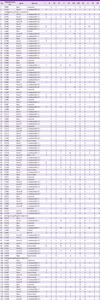1. Brooke JS.
Stenotrophomonas maltophilia: an emerging global opportunistic pathogen. Clin Microbiol Rev. 2012; 25:2–41.

2. Looney WJ, Narita M, Mühlemann K.
Stenotrophomonas maltophilia: an emerging opportunist human pathogen. Lancet Infect Dis. 2009; 9:312–323.
3. Chung HS, Hong SG, Lee Y, Kim M, Yong D, Jeong SH, Lee K, Chong Y. Antimicrobial susceptibility of
Stenotrophomonas maltophilia isolates from a Korean tertiary care hospital. Yonsei Med J. 2012; 53:439–441.

4. Nicodemo AC, Araujo MR, Ruiz AS, Gales AC.
In vitro susceptibility of
Stenotrophomonas maltophilia isolates: comparison of disc diffusion, Etest and agar dilution methods. J Antimicrob Chemother. 2004; 53:604–608.

5. Roscetto E, Rocco F, Carlomagno MS, Casalino M, Colonna B, Zarrilli R, Di Nocera PP. PCR-based rapid genotyping of Stenotrophomonas maltophilia isolates. BMC Microbiol. 2008; 8:202.
6. Valdezate S, Vindel A, Martín-Dávila P, Del Saz BS, Baquero F, Cantón R. High genetic diversity among
Stenotrophomonas maltophilia strains despite their originating at a single hospital. J Clin Microbiol. 2004; 42:693–699.

7. Cho S, Boxrud DJ, Bartkus JM, Whittam TS, Saeed M. Multiple-locus variable-number tandem repeat analysis of
Salmonella Enteritidis isolates from human and non-human sources using a single multiplex PCR. FEMS Microbiol Lett. 2007; 275:16–23.

8. van Belkum A. Tracing isolates of bacterial species by multilocus variable number of tandem repeat analysis (MLVA). FEMS Immunol Med Microbiol. 2007; 49:22–27.

9. Tan CK, Liaw SJ, Yu CJ, Teng LJ, Hsueh PR. Extensively drug-resistant
Stenotrophomonas maltophilia in a tertiary care hospital in Taiwan: microbiologic characteristics, clinical features, and outcomes. Diagn Microbiol Infect Dis. 2008; 60:205–210.

10. Toleman MA, Bennett PM, Bennett DM, Jones RN, Walsh TR. Global emergence of trimethoprim/sulfamethoxazole resistance in
Stenotrophomonas maltophilia mediated by acquisition of
sul gene. Emerg Infect Dis. 2007; 13:559–565.

11. Fihman V, Le Monnier A, Corvec S, Jaureguy F, Tankovic J, Jacquier H, Carbonnelle E, Bille E, Illiaquer M, Cattoir V, Zahar JR.
Stenotrophomonas maltophiliae-the most worrisome threat among unusual non-fermentative gram-negative bacilli from hospitalized patients: a prospective multicenter study. J Infect. 2012; 64:391–398.

12. Samonis G, Karageorgopoulos DE, Maraki S, Levis P, Dimopoulou D, Spernovasilis NA, Kofteridis DP, Falagas ME.
Stenotrophomonas maltophilia infections in a general hospital: patient characteristics, antimicrobial susceptibility, and treatment outcome. PLoS One. 2012; 7:e37375.
13. Cantó R, Valdezate S, Vindel A, Sáchez Del Saz B, Maíz L, Baquero F. Antimicrobial susceptibility profile of molecular typed cystic fibrosis Stenotrophomonas maltophilia isolates and differences with noncystic fibrosis isolates. Pediatr Pulmonol. 2003; 35:99–107.
14. Song JH, Sung JY, Kwon KC, Park JW, Cho HH, Shin SY, Ko YH, Kim JM, Shin KS, Koo SH. Analysis of acquired resistance genes in
Stenotrophomonas maltophilia
. Korean J Lab Med. 2010; 30:295–300.

15. Rhee JY, Choi JY, Choi MJ, Song JH, Peck KR, Ko KS. Distinct groups and antimicrobial resistance of clinical Stenotrophomonas maltophilia complex isolates from Korea. J Med Microbiol. 2013; 62:748–753.

16. Svensson-Stadler LA, Mihaylova SA, Moore ER.
Stenotrophomonas interspecies differentiation and identification by
gyrB sequence analysis. FEMS Microbiol Lett. 2012; 327:15–24.

17. Valenza G, Tappe D, Turnwald D, Frosch M, König C, Hebestreit H, Abele-Horn M. Prevalence and antimicrobial susceptibility of microorganisms isolated from sputa of patients with cystic fibrosis. J Cyst Fibros. 2008; 7:123–127.

18. Luber P, Bartelt E, Genschow E, Wagner J, Hahn H. Comparison of Broth Microdilution, E Test, and agar dilution methods for antibiotic susceptibility testing of
Campylobacter jejuni and
Campylobacter coli
. J Clin Microbiol. 2003; 41:1062–1068.

19. Clinical and Laboratory Standards Institute (CLSI). Performance standards for antimicrobial susceptibility testing, 21st informational supplement. Wayne, PA: CLSI;2011. p. M100-S21.
20. Wang WS, Liu CP, Lee CM, Huang FY.
Stenotrophomonas maltophilia bacteremia in adults: four years’ experience in a medical center in northern Taiwan. J Microbiol Immunol Infect. 2004; 37:359–365.
21. Galles AC, Jones RN, Sader HS. Antimicrobial susceptibility profile of contemporary clinical strains of Stenotrophomonas maltophilia isolates: can moxifloxacin activity be predicted by levofloxacin MIC results? J Chemother. 2008; 20:38–42.
22. Vartivarian S, Anaissie E, Bodey G, Sprigg H, Rolston K. A changing pattern of susceptibility of
Xanthomonas maltophilia to antimicrobial agents: implications for therapy. Antimicrob Agents Chemother. 1994; 38:624–627.

23. Gülmez D, Hascelik G.
Stenotrophomonas maltophilia: antimicrobial resistance and molecular typing of an emerging pathogen in a Turkish university hospital. Clin Microbiol Infect. 2005; 11:880–886.

24. Cho HH, Sung JY, Kwon KC, Koo SH. Expression of Sme efflux pumps and multilocus sequence typing in clinical isolates of
Stenotrophomonas maltophilia
. Ann Lab Med. 2012; 32:38–43.

25. Kaiser S, Biehler K, Jonas D.
Stenotrophomonas maltophilia multilocus sequence typing scheme for inferring population structure. J Bacteriol. 2009; 91:2934–2943.








 PDF
PDF ePub
ePub Citation
Citation Print
Print



 XML Download
XML Download